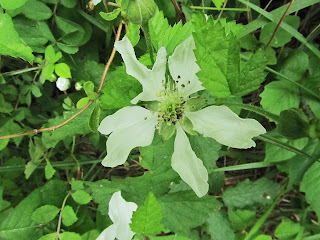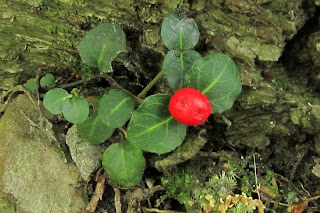Not sure about this one but it looks like a mint or a bergamot. Possibly Cat Mint.
One of my favorite ferns, the majestic Cinnamon Fern with erect fertile frond. Saw many of these!
These are very large ferns that branch out from a central point.They get their common name from these Cinnamon colored fronds or maybe from the rust colored fuzz that clings to their lower stems. Gold finches use the fuzz to line their nests! It is incredibly soft. It probably protects the plant from munching insects.
Common Whitetail Dragonfly male in his characteristic pose. I love the windowpanes in his wings (Clear areas).
A composite flower, possibly Daisy Fleabane, with a resident crab spider. Note the other blossoms with rays folded inward. If you look really closely at these types of composite blossoms, you will see that each yellow dot in the center is an individual flower. A hand lens or microscope will take you to another dimension--an insects eye view.
Rattlesnake Fern fertile frond with an insect visitor. Each of the little green baubles on the "rattle" is filled with spores. When the frond ripens and the air is dry they will pop open and the spores will be wind dispersed.
Mayapple blossom starting to fade. The flowers hang down like bells, hidden under large umbrella-like leaves, so its necessary to turn the flower upward to see the insides. The green pod will grow to resemble a tiny green apple
Interrupted Fern, the fertile portions carrying the sporangia "interrupt" the leaflets arranged on the stem of the frond.
Locust tree blossoms. Each blossom has a cup or inverted hood hiding the stamens. I want to observe how pollinators access the nectar on these. They give off a nice fragrance.
New York Fern, easy to identify because unlike most similar ferns in this area, the frond diminishes in width at both the top and the bottom. As in "New Yorkers burn the candle at both ends."
New York fern grows in patches rather than single clumps as do Cinnamon and Interrupted Fern.
Some type of vetch. Its purple but didn't match the picture of native Purple Vetch in my Peterson Guide. Possibly an alien.
A view of Rattlesnake Fern in whole. You can just make out the fertile frond extending upwards from the center.
Rue Anemone with Common Wood Sorrel (clover-like leaves) in background.
The Sorrel also blooms in white. Anemone in ancient Greek means "daughter of the wind" The plants in this genus have leaves that tremble in the slightest breeze, and many of the 150 species are referred to as "windflowers."
Solomon's Seal. This has flowers that droop, unlike the very similar Solomon's Plume, which in bloom has a spray of yellowish white at the end of the stem. One has to peep under the leaves to find these! You don't see the "bells" just walking by unless you recognize the plant from its leaves.
Rattlesnake Plantain, Goodyera pubescens, in the Orchidaceae family.
Rare to see the white orchid florescence since the deer find them very tasty.
Rare to see the white orchid florescence since the deer find them very tasty.
Partridgeberry

















Welcome Back, SMN! We missed you!!!
ReplyDeleteLove, boodledonk and pony